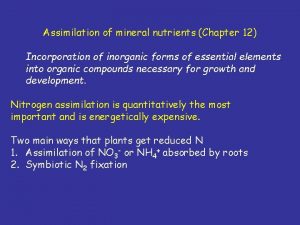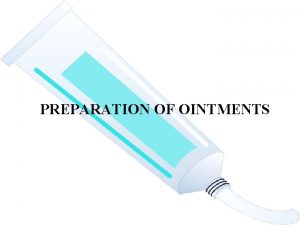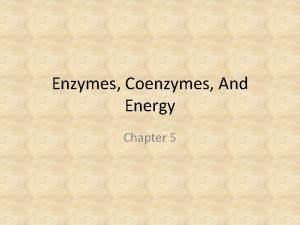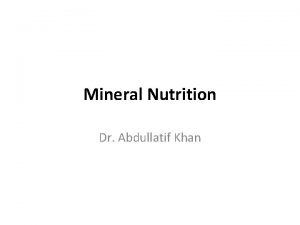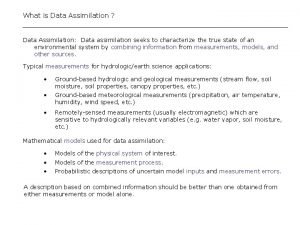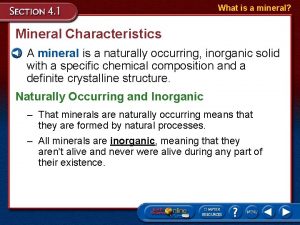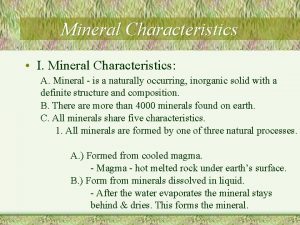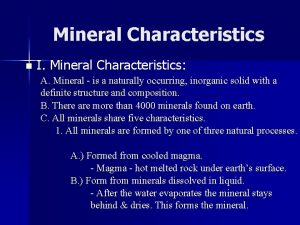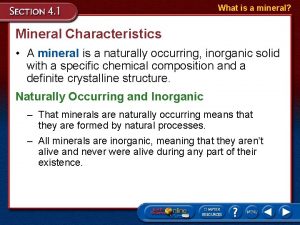Assimilation of mineral nutrients Chapter 12 Incorporation of


















- Slides: 18

Assimilation of mineral nutrients (Chapter 12) Incorporation of inorganic forms of essential elements into organic compounds necessary for growth and development. Nitrogen assimilation is quantitatively the most important and is energetically expensive. Two main ways that plants get reduced N 1. Assimilation of NO 3 - or NH 4+ absorbed by roots 2. Symbiotic N 2 fixation

The Nitrogen Cycle Fig. 12. 1

Microorganisms have a central role in almost all aspects of nitrogen availability and thus for life support on earth: * some bacteria can convert N 2 into ammonia by the process termed nitrogen fixation; these bacteria are either free-living or form symbiotic associations with plants or other organisms (e. g. termites, protozoa) * other bacteria bring about transformations of ammonia to nitrate, and of nitrate to N 2 or other nitrogen gases * many bacteria and fungi degrade organic matter, releasing fixed nitrogen for reuse by other organisms.

The Nitrogen Cycle

Nitrate and ammonium assimilation involves their conversion into amino acids Nitrate assimilation requires two reduction steps NO 3 - + NAD(P)H + H+ + 2 e- --> NO 2 - + NAD(P)+ + H 2 O enzyme is nitrate reductase NO 2 - + 6 Fdred + 8 H+ + 6 e- --> NH 4+ + 6 Fdox + 2 H 2 O enzyme is nitrite reductase


Biological Nitrogen Fixation converts N 2 gas into chemical forms usable by microbes and plants.




Examples of N 2 fixing plants of the Southwest Mesquite, Acacia, Palo Verde Symbionts are Rhizobium & Bradyrhizobium Lupines - Bradyrhizobium

Root nodules


Nitrogenase is the key enzyme in biological N fixation. A bacterial enzyme, not made by plants

Biological N fixation is energetically expensive, 16 ATP/N 2. Note that Molybdenum is a cofactor



 Which type of nutrition
Which type of nutrition Bill of rightts
Bill of rightts Selective incorporation definition
Selective incorporation definition Incorporation day.
Incorporation day. Consequences of incorporation
Consequences of incorporation Harriet josephine terry
Harriet josephine terry Profit prior to incorporation is
Profit prior to incorporation is Method of preparation of ointment
Method of preparation of ointment Asas place of incorporation
Asas place of incorporation Real seat theory vs incorporation theory
Real seat theory vs incorporation theory Profit prior to incorporation
Profit prior to incorporation Explain ratification of a pre incorporation contract
Explain ratification of a pre incorporation contract Procedure for incorporation of company
Procedure for incorporation of company Bvi incorporation
Bvi incorporation Chapter 10 nutrition for health lesson 2 nutrients
Chapter 10 nutrition for health lesson 2 nutrients Chapter 10 lesson 2 nutrients
Chapter 10 lesson 2 nutrients Chapter 5 nutrients at work
Chapter 5 nutrients at work Chapter 13 mineral resources and mining
Chapter 13 mineral resources and mining Ap psychology unit 7
Ap psychology unit 7
